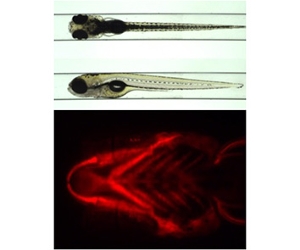Research project
High-throughput screening for developmental and reproductive toxicity
Can chemical safety assessment be improved with zebrafish embryo-based reporter assays?
- Duration
- 2016 - 2022
- Contact
- Herman Spaink
- Funding
-
 NWO equipment grants for COPAS and VAST screening systems
NWO equipment grants for COPAS and VAST screening systems
-
 European Commission Horizon 2020 programme. Project EU-ToxRisk, grant agreement no. 681002
European Commission Horizon 2020 programme. Project EU-ToxRisk, grant agreement no. 681002
- Partners

In the context of the European project EU-ToxRisk we aim to develop a high-throughput pipeline for fluorescence-based developmental toxicity evaluation using zebrafish reporters.
EU-ToxRisk is an Integrated European ‘Flagship’ Programme entitled "Driving Mechanism-based Toxicity Testing and Risk Assessment for the 21st century" coordinated by Bob van de Water of the Leiden Academic Center for Drug Research (LACDR). The research groups of Herman Spaink and Annemarie Meijer at the Institute of Biology Leiden (IBL) contribute to this project by developing novel zebrafish-based assays for chemical safety evaluation.
This overall goal of the EU-ToxRisk project is to drive a paradigm shift in toxicology towards an animal-free, mechanism-based integrated approach to risk assessment of chemicals. Reduction or replacement of animal use is expected to be achieved by novel systems biology approaches using human cell-based assays and organ cultures. In addition, the use of the early life stages of zebrafish (embryos and larvae before the free-feeding stage) is considered an alternative for animal experimentation under current European legislation.
For evaluation of developmental and reproductive toxicity (DART) we will use zebrafish fluorescent reporter lines labelling different tissues and organs, such as liver, bone, and the vascular system. Furthermore, for evaluation of immunological toxicity we will use reporter lines that allow quantification of effect on immune system development and function. These zebrafish fluorescent reporters will be integrated with quantitative image analysis pipelines using two high-throughput screening platforms that have been acquired with NWO funding: the COPAS system, a large particle flow cytometer, and the VAST Bioimager (Vertebrate Automated Screening Technology), a system that automates the zebrafish handling and cellular-resolution imaging tasks for high-content screens.
